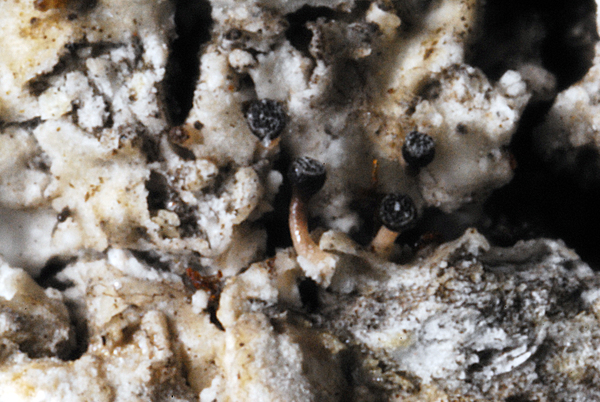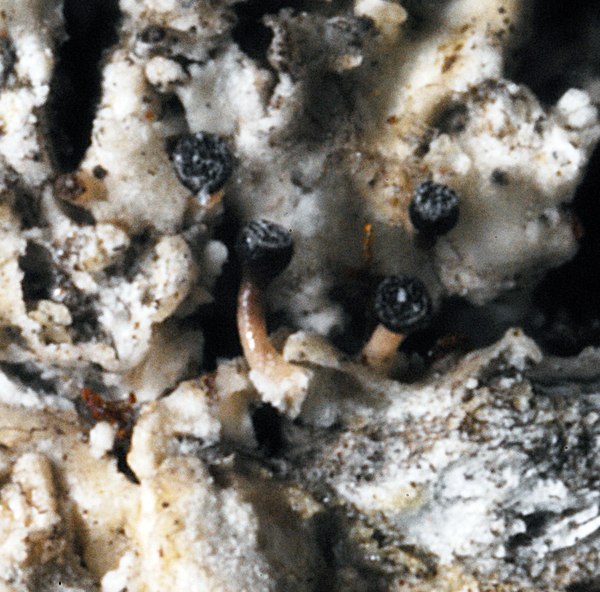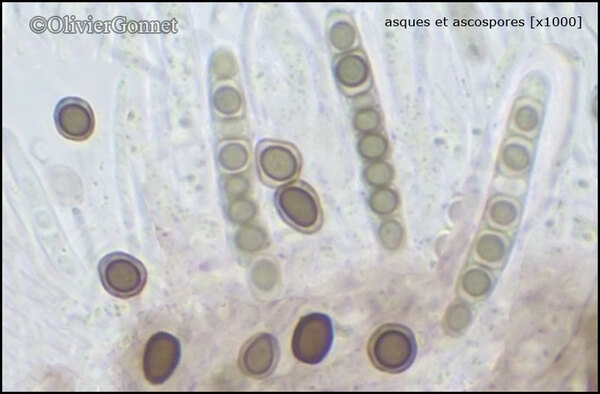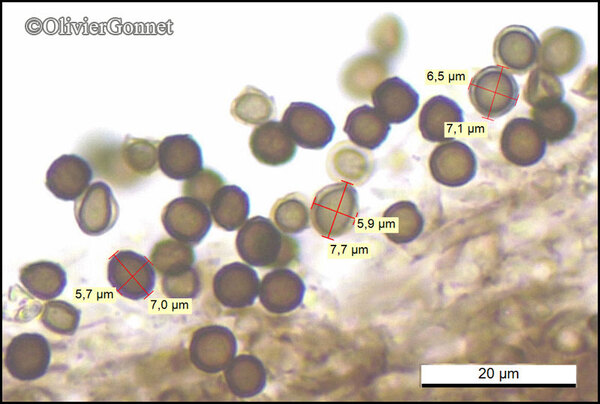Sphinctrina leucopoda Nyl.
Syn. Lich., 1, 2: 144, 1860.
Synonyms: Sphinctrina obscurata sensu Nádv. non (Nyl.) Nádv.; Sphinctrina pedata (Stenh.) R. Sant.
Distribution: C - Tosc (Puntillo & Puntillo 2009, Brackel 2016), Marc (Nimis & Tretiach 1999, Puntillo & Puntillo 2009, Brackel 2016), Umb (Ravera 1998, Ravera & al. 2006, Puntillo & Puntillo 2009, Brackel 2016), Laz (Puntillo & Puntillo 2009, Brackel 2016), Abr (Nascimbene & al. 2021), Sar (Puntillo & Puntillo 2009, Brackel 2016). S - Camp (Nimis & Tretiach 2004 Puntillo & Puntillo 2009, Garofalo & al. 2010, Brackel 2016), Cal (Puntillo 1996, Puntillo & Puntillo 2009, Brackel & Puntillo 2016, Brackel 2016), Si (Brackel 2008b, 2016).
Description: Thallus not evident, not lichenized. Apothecia short-stalked, 0.2-0.3 mm high, usually developing on the thalli of epiphytic Pertusaria-species. Stalk pale to dark brown, rarely black, of periclinally arranged hyphae, pale in inner part, dark brown to reddish in outermost part. Capitulum dark brown to black, distinctly darker than stalk, glossy, subglobose to slightly compressed vertically, 0.1-0.2 mm across. Exciple well-developed, dark brown, in upper part consisting of 4-6 layers of periclinally arranged, sclerotized hyphae; mazaedium well-developed, black; hypothecium colourless. Asci 8-spored, cylindrical, formed singly from ascogenous hyphae with croziers, with a single, functional wall layer, K/I-, disintegrating at a rather late stage, with uniseriately arranged spores. Ascospores 1-celled, dark brown, subglobose, 4-6 x 4-7 µm, with an indistinct, minute ornamentation of irregular cracks. Photobiont absent. Spot tests: K-, C-, KC-, P-. Chemistry: without lichen substances.Note: a parasite on the thalli of epiphytic crustose lichens, mostly Pertusaria pertusa; widespread in Peninsular Italy and to be looked for in the Alps, but certainly declining. Earlier records from Sicily (Caniglia & Grillo, 2003, Grillo & Caniglia, 2004), not validated by Puntillo & Puntillo (2009), are excluded.
Growth form: Lichenicolous fungus
Substrata: bark
Reproductive strategy: mainly sexual
Most common in areas with a humid-warm climate (e.g. most of Tyrrenian Italy)
paras Pertusaria spp.
Commonnes-rarity: (info)
Alpine belt: absent
Subalpine belt: absent
Oromediterranean belt: absent
Montane belt: very rare
Submediterranean belt: extremely rare
Padanian area: absent
Humid submediterranean belt: very rare
Humid mediterranean belt: absent
Dry mediterranean belt: absent
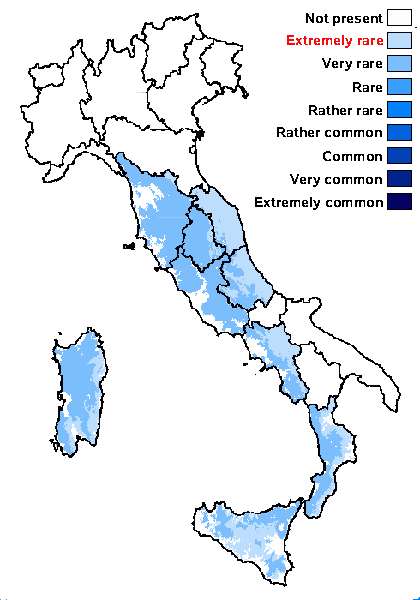
Predictive model
Herbarium samples
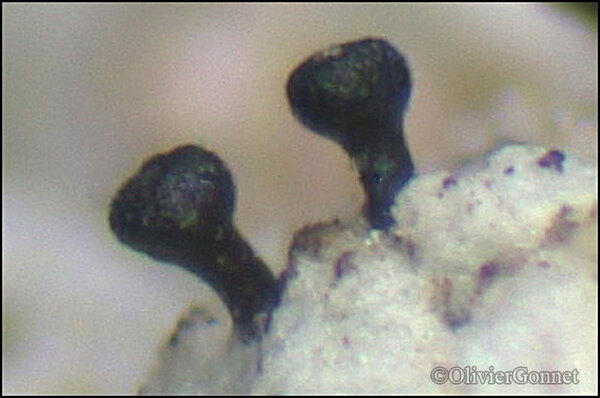
Courtesy Danièle et Olivier Gonnet - Source: https://www.afl-lichenologie.fr/Photos_AFL/Photos_AFL_S/Text_S2/Sphinctrina_leucopoda.htm
France, 10/10/2018 - Ajaccio, Pointe de la Parata, alt.5 m - Corse
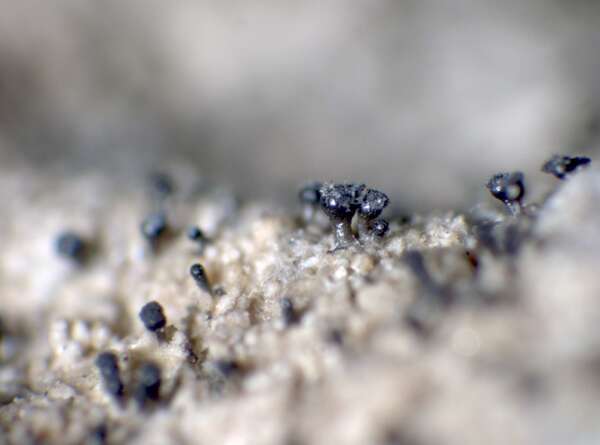

P.L. Nimis; Owner: Department of Life Sciences, University of Trieste
Herbarium: TSB (12131)
2001/11/30
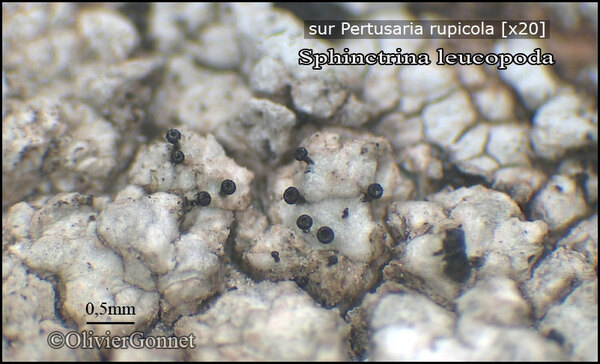
Courtesy Danièle et Olivier Gonnet - Source: https://www.afl-lichenologie.fr/Photos_AFL/Photos_AFL_S/Text_S2/Sphinctrina_leucopoda.htm
France, 10/10/2018 - Ajaccio, Pointe de la Parata, alt.5 m - Corse
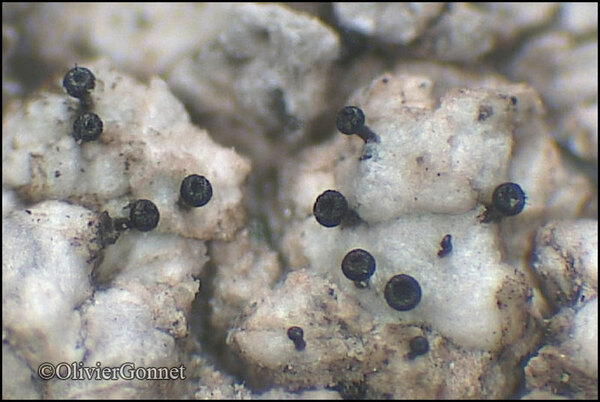
Courtesy Danièle et Olivier Gonnet - Source: https://www.afl-lichenologie.fr/Photos_AFL/Photos_AFL_S/Text_S2/Sphinctrina_leucopoda.htm
France, 10/10/2018 - Ajaccio, Pointe de la Parata, alt.5 m - Corse

Courtesy Danièle et Olivier Gonnet - Source: https://www.afl-lichenologie.fr/Photos_AFL/Photos_AFL_S/Text_S2/Sphinctrina_leucopoda.htm
France, 10/10/2018 - Ajaccio, Pointe de la Parata, alt.5 m - Corse
Growth form: Lichenicolous fungus
Substrata: bark
Reproductive strategy: mainly sexual
Most common in areas with a humid-warm climate (e.g. most of Tyrrenian Italy)
paras Pertusaria spp.
Commonnes-rarity: (info)
Alpine belt: absent
Subalpine belt: absent
Oromediterranean belt: absent
Montane belt: very rare
Submediterranean belt: extremely rare
Padanian area: absent
Humid submediterranean belt: very rare
Humid mediterranean belt: absent
Dry mediterranean belt: absent

Predictive model
| Herbarium samples |

Courtesy Danièle et Olivier Gonnet - Source: https://www.afl-lichenologie.fr/Photos_AFL/Photos_AFL_S/Text_S2/Sphinctrina_leucopoda.htm
France, 10/10/2018 - Ajaccio, Pointe de la Parata, alt.5 m - Corse


P.L. Nimis; Owner: Department of Life Sciences, University of Trieste
Herbarium: TSB (12131)
2001/11/30

Courtesy Danièle et Olivier Gonnet - Source: https://www.afl-lichenologie.fr/Photos_AFL/Photos_AFL_S/Text_S2/Sphinctrina_leucopoda.htm
France, 10/10/2018 - Ajaccio, Pointe de la Parata, alt.5 m - Corse

Courtesy Danièle et Olivier Gonnet - Source: https://www.afl-lichenologie.fr/Photos_AFL/Photos_AFL_S/Text_S2/Sphinctrina_leucopoda.htm
France, 10/10/2018 - Ajaccio, Pointe de la Parata, alt.5 m - Corse

 Index Fungorum
Index Fungorum
 GBIF
GBIF
